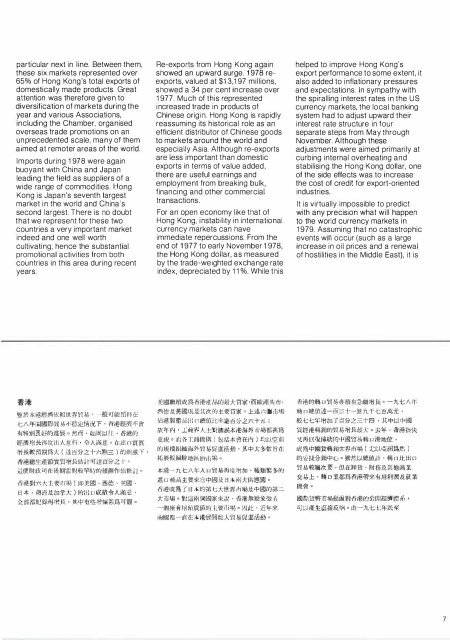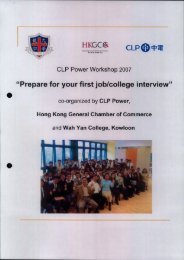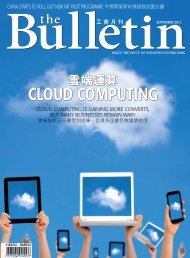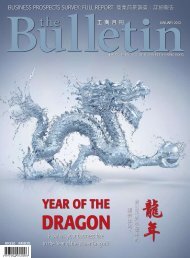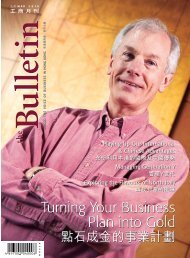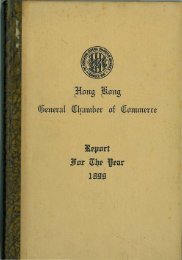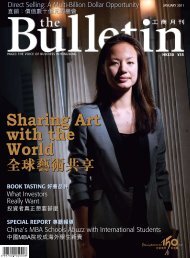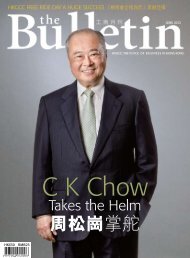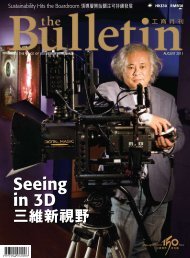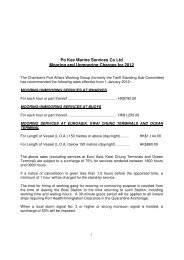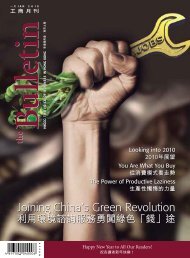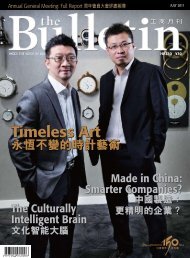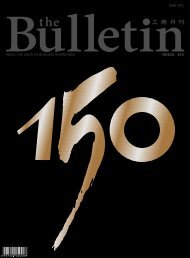1978 - The Hong Kong General Chamber of Commerce
1978 - The Hong Kong General Chamber of Commerce
1978 - The Hong Kong General Chamber of Commerce
You also want an ePaper? Increase the reach of your titles
YUMPU automatically turns print PDFs into web optimized ePapers that Google loves.
particular next in line. Between them,<br />
these six markets represented over<br />
65% <strong>of</strong> <strong>Hong</strong> <strong>Kong</strong>'s total exports <strong>of</strong><br />
domestically made products. Great<br />
attention was therefore given to<br />
diversification <strong>of</strong> markets during the<br />
year and various Associations,<br />
including the <strong>Chamber</strong>, organised<br />
overseas trade promotions on an<br />
unprecedented scale, many <strong>of</strong> them<br />
aimed at remoter areas <strong>of</strong> the world.<br />
Imports during <strong>1978</strong> were again<br />
buoyant with China and Japan<br />
leading the field as suppliers <strong>of</strong> a<br />
wide range <strong>of</strong> commodities. <strong>Hong</strong><br />
<strong>Kong</strong> is Japan's seventh largest<br />
market in the world and China's<br />
second largest. <strong>The</strong>re is no doubt<br />
that we represent for these two<br />
countries a very important market<br />
indeed and one well worth<br />
cultivating, hence the substantial<br />
promotional activities from both<br />
countries in this area during recent<br />
years.<br />
Re-exports from <strong>Hong</strong> <strong>Kong</strong> again<br />
showed an upward surge. <strong>1978</strong> reexports,<br />
valued at $13,1 97 millions,<br />
showed a 34 per cent increase over<br />
1977. Much <strong>of</strong> this represented<br />
increased trade in products <strong>of</strong><br />
Chinese origin. <strong>Hong</strong> <strong>Kong</strong> is rapidly<br />
reassuming its historical role as an<br />
efficient distributor <strong>of</strong> Chinese goods<br />
to markets around the world and<br />
especially Asia. Although re-exports<br />
are less important than domestic<br />
exports in terms <strong>of</strong> value added,<br />
there are useful earnings and<br />
employment from breaking bulk,<br />
financing and other commercial<br />
transactions.<br />
For an open economy like that <strong>of</strong><br />
<strong>Hong</strong> <strong>Kong</strong>, instability in international<br />
currency markets can have<br />
immediate repercussions. From the<br />
end <strong>of</strong> 1977 to early November <strong>1978</strong>,<br />
the <strong>Hong</strong> <strong>Kong</strong> dollar, as measured<br />
by the trade-weighted exchange rate<br />
index, depreciated by 11%. While this<br />
helped to improve <strong>Hong</strong> <strong>Kong</strong>'s<br />
export performance to some extent, it<br />
also added to inflationary pressures<br />
and expectations. In sympathy with<br />
the spiralling interest rates in the US<br />
currency markets, the local banking<br />
system had to adjust upward their<br />
interest rate structure in four<br />
separate steps from May through<br />
November. Although these<br />
adjustments were aimed primarily at<br />
curbing internal overheating and<br />
stabilising the <strong>Hong</strong> <strong>Kong</strong> dollar, one<br />
<strong>of</strong> the side effects was to increase<br />
the cost <strong>of</strong> credit for export-oriented<br />
industries.<br />
lt is virtually impossible to predict<br />
with any precision what will happen<br />
to the world currency markets in<br />
1979. Assuming that no catastrophic<br />
events will occur (such as a large<br />
increase in oil prices and a renewal<br />
<strong>of</strong> hostilities in the Middle East), it is<br />
ln*$b'!fiJdfit!tW'f'(JJ., · ·Mll:ilTfffifJIN


